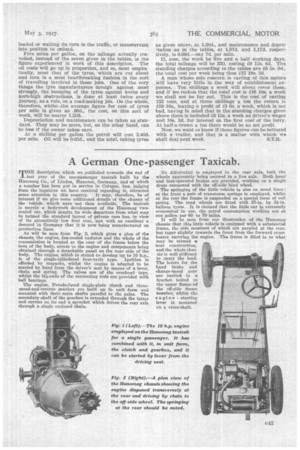A German One-passenger Taxicab.
Page 67

If you've noticed an error in this article please click here to report it so we can fix it.
THE description which we published towards the and of last year of the one-passenger taxicab built by the Hanomag Co., of Linden, Hanover, Germany, and of which a number has been put in service in Cologne, has, judging from the inquiries we have received regarding it, attracted some attention in this country. It may, therefore, be of interest if we give some additional details of the .chassis of the vehicle which were not then available. The taxicab is merely a bodywork development of the Hanomag twoseated car, which despite its wide departure from what may be termed the standard layout of private cars has, in view of its attractively low first cost, met with so excellent a demand in Germany that it is now being manufactured on production lines.
As will be seen from Pig. 2, which gives a plan of the chassis, the engine, fan-cooled radiator and the whole of the transmission is located at the rear of the frame below the boot of the body, access to the engine and components being obtained through a detachable panel on the near side of the body. The engine, which is stated to develop up to 10 h.ne is of the singIe-cylindered four-cycle type. Ignition is effected by magneto, whilst the engine is adapted to be started by hand from the driver's seat by means of a lever, chain and spring. The valves are of the overhead type, whilst the big-ends of the connecting reds are provided wikh ball bearings.
The engine, Fereclo-faced single-plate clutch and threespeed-and-reverse gearbox are built up in unit form and mounted with their main shafts parallel to the axles. The secondary shaft of the gearbox is extended through the latter and carries on its end a sprocket which drives the rear axle through a single enclosed chain. No differential is employed in the rear axle, both the wheels apparently being secured to a live axle. Both hand and foot-operated brakes are provided, working on a eingle drum connected with the off-side bind wheel.
The springing of the little vehicle is also on novel lines; at the front a pair of transverse springs is employed, whilst at the rear the frame is suspended on a special form of coil spring. The road wheels are fitted with 27-in. by 31-in. balloon tyres. It is claimed that the little car is extremely economical in use, the petrol consumption working out at one gallon per 60 to 70 miles.
It will be seen from our illustration of the Hanomag chassis that this little vehicle is equipped with a substantial frame, the side members of which are parallel at the rear, but taper slightly towards the front from the forward crossbearer carrying the engine. The frame is filled in to what may he termed ei boat construction, and the whole chassis is well stiffened to carry the load. The levers for the hand brake and change-speed gear are carried in a bracket bolted to the upper flange of the off-side frame member, whilst the engine starting lever is mounted on a cross-shaft. ,












































































































